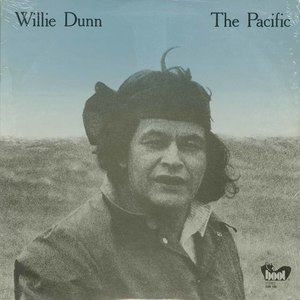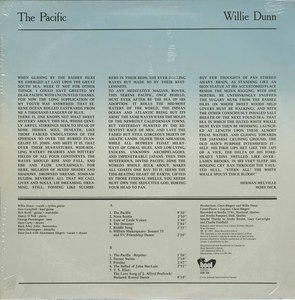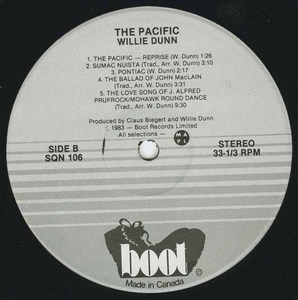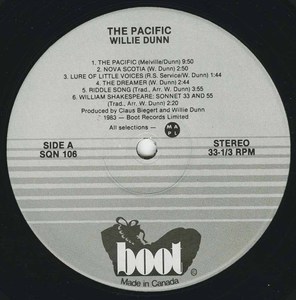Information/Write-up
Willie Dunn was a Canadian folk musician, filmmaker, poet, and activist whose art remains one of the most profound testaments to Indigenous experience in the modern era. Born William Lawrence Dunn on August 14, 1941, in Montreal, Quebec, he was of Mi’kmaq and Scottish-Irish ancestry. His Mi’kmaq name, Roha’tiio—“his voice is beautiful”—spoke to a life guided by song, story, and truth. After leaving school in his teens, Dunn served in the Canadian Armed Forces from 1960 to 1963, earning a United Nations medal for service in the Congo. Upon returning home, he turned his attention to the guitar and began performing in Montreal’s folk coffeehouses, drawn to the topical songwriting of Woody Guthrie and Pete Seeger but determined to tell stories from his own people’s history.
Dunn opened a small coffeehouse in Montreal called the Totem Pole, where he hosted local poets, activists, and fellow musicians. His deep, solemn voice and unhurried phrasing gave his songs a rare gravity. When he performed I Pity the Country—his 1971 masterpiece lamenting greed, corruption, and colonial oppression—listeners heard an entire philosophy of resistance compressed into three minutes of acoustic austerity. “I pity the country, I pity the state,” he sang, his voice heavy with both compassion and fury.
His uncompromising outlook made him a difficult fit for the commercial music industry. He turned down early interest from Columbia Records, rejecting their plan to market him as a “rebel cowboy.” On another occasion he smashed his guitar in protest during a Glen Campbell tour, calling the entourage “a bunch of phonies.” When filming Queen Elizabeth II for a documentary, he quietly told her, “We are not your children anymore.” Such gestures of defiance cost him opportunities, but they cemented his integrity. Dunn was never interested in fame—only in truth.
In 1968, he joined the National Film Board of Canada as part of its newly formed Indian Film Crew, the first Indigenous production unit in NFB history. There, he wrote and directed The Ballad of Crowfoot, a ten-minute film set to his own song about the Siksika leader Isapo-muxika and the broken treaties of the Plains. Combining still photography, poetry, and music, it became one of the first films directed by an Indigenous Canadian and earned the Gold Hugo at the 1969 Chicago International Film Festival. Teachers across North America used it to introduce Indigenous history in classrooms, and it is now widely regarded as Canada’s first true music video. Dunn followed with These Are My People (1969), The Other Side of the Ledger (1972), and later contributed music to Alanis Obomsawin’s Incident at Restigouche (1984) and Okanada (1990), continuing his lifelong merging of art and activism.
Around 1970, between his NFB films and his debut LP, Dunn recorded a series of radio transcription discs for CBC Radio Canada titled Who Were the Ones?—a thirteen-part series of songs and spoken ballads written and sung by Dunn for the CBC’s Northern Service. Issued as multiple LPs (E-789 through E-797), the series combined his original compositions and historical narratives, including Louis Riel, Pontiac, and Ode to an Indian Girl, performed in stripped-down acoustic settings. These recordings represent Dunn’s earliest professional studio work following The Ballad of Crowfoot and preserve his voice at its most intimate and documentary in tone, bridging his storytelling, music, and oral tradition.
His self-titled debut album Willie Dunn (1971) revealed a songwriter of uncommon moral vision. Songs such as Charlie—about the Ojibwe boy Chanie Wenjack, who fled a residential school and died trying to return home—stand among Canada’s most devastating ballads. A re-recorded version of the same album followed in 1972 for charity. During this period Dunn also collaborated with Vancouver composer Ann Mortifee on music for the celebrated stage play The Ecstasy of Rita Joe, featuring Chief Dan George and Paul Horn, later released on CBC Transcription E-849 (1973) and United Artists / Kerygma Records.
Throughout the 1970s and 1980s, Dunn expanded his musical scope. His 1980 album The Pacific contained meditative spoken-word pieces and songs layered with nature sounds, as on Pontiac, where he sang over recordings of birdsong. Sonnet 33 and 55 / Friendship Dance blended Shakespearean verse with traditional Akwesasne rhythms. His later albums Metallic (1999) and Son of the Sun (2004) revisited earlier material with renewed spiritual intensity. The title song Son of the Sun was later covered by the Innu duo Kashtin, whose success brought Dunn’s writing to new audiences.
Dunn’s songs were often stark and mournful, but never hopeless. They spoke of injustice while believing in renewal—an understanding rooted in Mi’kmaq cosmology and human empathy. “I’m a topical folksinger,” he once said. “The topic of being an Indian became so prevalent in my music that I became known as an Indian folksinger.” His deep baritone and poetic lyricism drew comparisons to Leonard Cohen, with whom he shared Montreal roots, but Dunn’s language was anchored in oral tradition and ancestral memory.
Despite his growing recognition, Dunn lived much of his life on the margins. He was frequently arrested at protests and endured long periods of depression as his records went out of print. CBC radio host Johnny Yesno, one of his early champions, recalled that audiences constantly wrote in asking where to buy Dunn’s songs—only to learn that they were unavailable. “Most of the time,” he said, “you can’t even find him.” Still, Dunn’s influence spread quietly through the generations. His song Son of the Sun inspired young Indigenous artists in the 1990s, while I Pity the Country became an anthem for Indigenous rights movements and was later covered by Leanne Betasamosake Simpson.
In later years, Dunn became increasingly involved in politics, working with the Company of Young Canadians and running as the New Democratic Party candidate for Ottawa–Vanier in the 1993 federal election. He remained a respected elder within the artistic community, mentoring emerging Indigenous filmmakers and songwriters. In 2005, he was inducted into Edmonton’s Aboriginal Walk of Honour and received a Lifetime Achievement Award from the Canadian Aboriginal Music Awards.
Willie Dunn passed away on August 5, 2013, in Ottawa, Ontario, days shy of his 72nd birthday. His body of work—spanning six decades of song, film, and poetry—stands as one of the cornerstones of Indigenous cultural expression in Canada. His voice continues to echo through the hills, rivers, and archives he sang about: the sound of a nation remembering itself.
-Robert Williston
Willie Dunn became known in the early 1970s as a folksinger and poet of songs about his Indian heritage. The child of an Red Indian mother and a father from Scotland he is a singer with contradictions which he doesn´t try to hide.
Willie Dunn: vocals, guitar
Bob Robb: guitar, mandolin
Recorded at Studio 1714, Montreal, Quebec, Canada; Studio Passport, Hull, Quebec, Canada.





No Comments